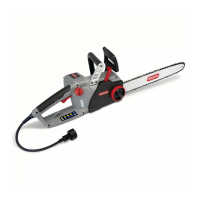8
Chainsaw Model CS1500
Important Safety Instructions
• Cut wood only. Do not use the chainsaw
for purposes not intended. For example:
do not use chainsaw for cutting plastic,
masonry or non-wood building materials. Use
of the chainsaw for operations different than
intended could result in a hazardous situation.
• It is recommended that the first time user
should have practical instruction in the
use of the chainsaw and the recommended
protective equipment from an experienced
operator. The initial practice should be
cutting logs on a saw-horse or cradle.
• Other than the wear parts identified in
this manual, the chainsaw has no user
serviceable parts.
• The work piece, bar and chain can be hot
after cutting. Wear gloves to avoid burns.
• Prolonged use of power tools has been
reported to cause vascular, muscular
and/or neurological disorders (such
as vibration white finger or Raynaud’s
syndrome), particularly when operating
the tool in cold weather. If you experience
numbness or loss of feeling in your
extremities, stop using the tool until
symptoms fade. To reduce the incidence
of vibration induced trauma, follow these
instructions:
– Wear gloves and keep hands and body
warm.
– Maintain a firm grip on the chainsaw,
but do not use prolonged, excessive
pressure. Let the chainsaw do the work.
– Assure that the cutting system is
maintained properly.
– Take frequent breaks.
The vibration in normal use can differ from
the stated values in this manual, depending
on the material being cut, maintenance of the
cutting system and other factors.
• Keep the meter cord behind you, and
know the position of the meter cord at
all times. Keeping the meter cord behind
you and knowing the position of the meter
cord will help minimize tripping hazards and
prevent severing of the meter cord with the
chainsaw.
• If the meter cord is cut or damaged,
immediately stop using the chainsaw
and disconnect the meter cord from
the mains. A damaged or cut meter cord
increases the risk of electrical shock.
• When used in a wet environment, use a
GFCI with a tripping current of less than
mA. Use of a GFCI reduces the risk of
electric shock.
Causes and Operator Prevention
of Kickback
Kickback may occur when the nose or tip of the
guide bar touches an object, or when the wood
closes in and pinches the saw chain in the cut.
Tip contact, in some cases, may cause a sudden
reverse reaction, kicking the guide bar up and
back towards the operator.
Pinching the saw chain along the top of the
guide bar may push the guide bar rapidly back
towards the operator.
Either of these reactions may cause you to
lose control of the saw which could result in
serious personal injury. Do not rely exclusively
on the safety devices built into your saw. As a
chainsaw user, you should take several steps
to keep your cutting jobs free from accident and
injury.
Kickback is the result of tool misuse and/or
incorrect operating procedures or conditions
and can be avoided by taking proper
precautions as given below:
• Maintain a firm grip with thumbs and fingers
encircling the chainsaw handles, with both
hands on the saw and position your body and
arm to allow you to resist kickback forces.
Kickback forces can be controlled by the
operator , if proper precautions are taken. Do
not let go of the chainsaw.
• Do not overreach and do not cut above
shoulder height. This helps prevent
unintended tip contact and enables better
control of the chainsaw in unexpected
situations.

